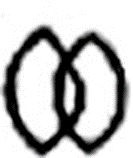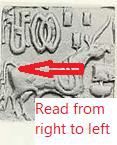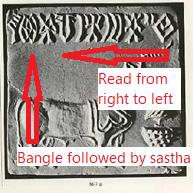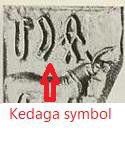Bangle symbol indicates mother goddess
Bangles symbol suggest the idea of a female goddess.
Abstract:
Asko Parpola says that the two rings symbol indicates the idea of ‘protection’. In addition to that, there is a possibility that the bangles could have suggested the mother goddess ‘Kali’ also. Details are as given below:
Picture courtesy – Sue Sullivan (1)
Asko Parpola proposes that the three strokes symbol indicates three stones used to make a temporary fireplace for cooking. Along with the bangle logo, this pair of characters stand for the word ‘Cal Kappu’ (pregnancy protection) (Tamil word) (2 p. 228). But, my research finding so far indicates that the Indus script follows the Egyptian hieroglyphic way of writing, and there is a distinct meaning for this symbol. It means ‘dangerous god.’ Read my article,‘ Number three means dangerous gods’ for more information.
See the above-given inscription; the bangle symbol is followed by the ‘Sastha’ (god) symbol. (3) The last two logos should be read as ‘Bangle Sastha’; the female goddess is probably Gauri/ Kali.
The above-given grapheme of the bangle with tail is occurring only once, as per the concordance list of Mahadevan. (4) Earlier, I was under the impression that it was a ‘tail’ symbol. I have to revise that idea; the tail-like appendage indicates the ‘ka‘ (soul) symbol. It is not tail; it suggests a hand. The composite grapheme means ‘protection’ to a soul in the netherworld.
The above-given seal inscription shows the ‘Kedaga’ symbol in the middle. The engraving should be read as ‘Pithru-Kedaga-Kavu’ (read from right to left). The meaning of the word is ‘manes –
protection – sacrifice’. The ‘Kedaga’ symbol gives a clear-cut meaning of ‘protection’. In such a situation, there is no need for an additional symbol for the same meaning. Hence, it can be safely concluded that the ‘Bangle symbol’ stands for something in addition to the meaning ‘protection’.
Statistical analysis of the symbol gives some idea




| 1 | 93 | |
| 2 | 48 | |
| 3 | 13 | |
| 4 | 5 | |
| 5 | 1 | |
| Total frequency | 160 |
All the above given five variants are the modified form of the same idea. Serial number four shows the bangle symbol within four apostrophe marks, which indicates a ‘god’ in Indus seal inscriptions.
Frequency of pairs involving bangle symbol
| Symbol pairs | Frequ ency | Reading of the inscription | comments | |
| 1 |  |
34 | The inscription read as ‘Bangle goddess -dvi- Kavu.’ | This reading is quite reasonable – Agreeable |
| 2 |  |
27 | The inscription read as ‘Dangerous Bangle god.’ | Number three indicates – the name of the god is too dangerous to be written – as per Egyptian Hieroglyphics, the same is applicable in the case of Indus script, also |
| 3 | 26 | Bangle Sastha | This reading is the best option, which shows the
link between Bangle goddess and the word Sastha(god) |
|
| 4 | 21 | Bangle Kavu | Kavu meant for bangle goddess | |
| 5 | 17 | Bangle goddess –
Karkida month sacrifice |
This reading suggests that ‘karkida sacrifice
‘meant for bangle goddess |
|
| 6 | 12 | Dangerous –
Bangle goddess |
This reading is quite logical –The Goddess Kali is
always considered dangerous |
|
| 7 | 11 | Sastha -Bangle | The direction of reading is not clear — this can
be appropriately read-only after considering the adjoining symbols |
|
| 8 | 10 | Bangle Sastha | This reading is the same as given in serial
number three, which shows the link between Bangle goddess and the word Sastha(god) In addition to that, the three vertical lines within the bangles might have indicated the ‘danger – god’ sign |
The details given in the above-given table shows that the combination of ‘bangle – goddess’ appears in many pairs. And it is reasonable to conclude that the bangle symbol indicates ‘mother




goddess’. The frequency data is taken from the research paper of Sundar et al. (4)
In addition to that ‘dangerous god–bangle goddess’ association occurs 27 times in Indus seal inscriptions. It is a statistically significant number. Hence, the idea of a ‘bangle symbol’ indicating mother goddess Gauri/ Kali is reasonably supported by the above- presented discussions. However, the concept of protection proposed by Asko Parpola is also equally applicable.
Bibliography
- Sullivan, Sue. The Indusscript dictionary. s.l. : Suzanne Redalia (Publisher), 2011.
- Parpola, Asko. Decipheringthe Indusscript. New York : Cambridge University Press, 2000.
- Jeyakumar(Sastha). Branch_symbol_indicates_the_word_Sastha. academia.edu. [Online] 2016. https://www.academia.edu/31658123/Branch_symbol_indicates_the_word_Sastha..
- Mahadevan.I. The Indus script -Text, Concordance and Tables. http://www.rmrl.in. [Online] http://www.rmrl.in/wp-content/uploads/2014/02/papers/5a.pdf.
- Sundar. -The-Indus-Script-Text-and-Context.pdf. http://45.113.136.87/wp-content/uploads/. [Online] http://45.113.136.87/wp-content/uploads/43-The-Indus-Script-Text-and-Context.pdf.






